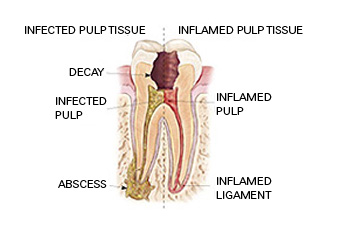A new filling or crown will injure the pulp, typically causing mild inflammation that resolves spontaneously. Occasionally, a pulp cannot recover after a new filling or crown and root canal treatment will be necessary.
There are a variety of other stimuli that can cause inflammation and infection of the pulp; they include a deep cavity, a crack or chip in the tooth, clenching, grinding, and trauma.
A congenitally malformed tooth has a higher risk of requiring endodontic treatment. This is often due to its anatomy not adequately protecting the pulp. For instance the enamel may be thin or malformed.
A dentist may suggest a prophylactic (preventive) root canal treatment if a planned filling or crown will extend close to the pulp. The rationale for this recommendation is the act of restoring the tooth may irritate the pulp to such an extent that it will not be able to recover. Such teeth can become extremely sensitive and sore shortly after the 'freezing' (local anaesthetic) wears-off.
A tooth that remains sensitive to hot, cold or biting for several weeks after a new filling or crown should first be evaluated to ensure the bite is not high. If the bite is not high and problems persist, an evaluation for endodontic treatment is necessary. Every filling and crown procedure is an injury to the pulp. Most often the pulp is able to recover, but when it does not recover a root canal treatment is warranted.
When pain and swelling are severe, it is easy to understand why endodontic treatment is necessary. However, pulp damage and death can occur without any signs or symptoms (i.e. no pain or swelling). It is important to have dental x-rays and an annual clinical exam by a dentist to ensure such problems are detected before they become severe.
No Symptoms?
Below is an example of a tooth that required endodontic treatment despite the absence of pain, sensitivity, or swelling. During a routine annual hygiene appointment a check x-ray was taken. The dentist recommended this x-ray even though there were no obvious problems. It had merely been a few years since an x-ray was taken and the dentist thought it prudent to re-check the area.
Fortunately the x-ray was taken as it shows a large infective lesion associated with a pain-free tooth. The red arrows highlight a dark area in the bone. This area of infection is centred near the root of tooth No. 24 (upper left tooth behind the eye tooth). The pulp in this tooth had died a long time ago, bacteria slowly colonised the canal space, and the infective lesion eventually became large enough to be detected on an x-ray. If left untreated the infective process would continue to progress resulting in pain or swelling. This is a matter of 'when' such problems would arise not 'if'.
When this tooth was endodontically evaluated it was found to not respond to cold despite the fact the teeth in front and behind it did. There was no tenderness to bite or palpation of the surrounding gums.
This is a classic example of a pulp dying quietly
Root canal treatment was performed on this tooth, ending the infective process, and allowing the bone to heal. Over the next few years, the tooth will continue to be closely monitored to ensure complete healing occurs. Successful endodontic treatment results in a functional tooth that looks and feels like all the other teeth in your mouth. If detected early enough it can also prevent such problems from ever developing.
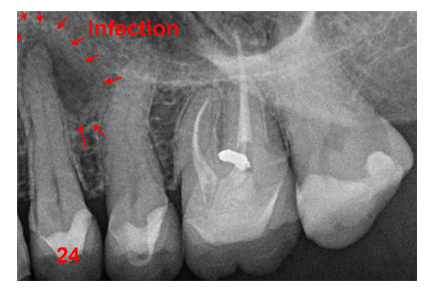

Large Cavities?
Cavities can get large enough that their removal will irritate the pulp too much. If left untreated the cavities will continue to grow and eventually extended into the pulp chamber itself. Below is an example of two teeth that had previously been sensitive to cold drinks. The cold sensitivity had recently gone away, but the patient noticed a large section of one of the teeth had broken off.
This is an example of a small cavity that grew over time. As it grew it caused the pulp to become sensitive to cold. As it grew further the pulp eventually died and the sensitivity went away. However, the cavity had grown large enough that parts of the tooth had started to break down. It is important to floss your teeth to prevent such 'flossing' cavities from developing. Your dentist can examine your teeth clinically and review x-rays to find cavities before they get so large that a root canal treatment is necessary.
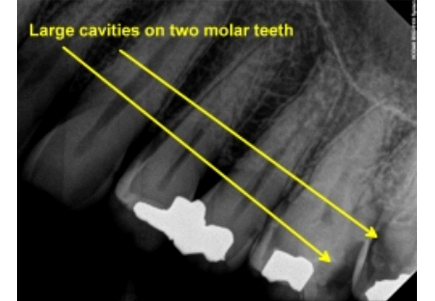 |
The x-ray shows two large cavities |
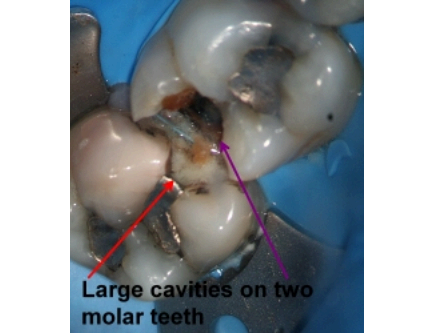 |
A clinical view of the teeth |
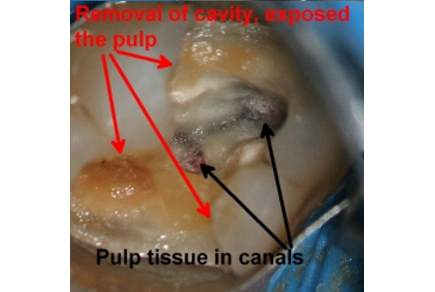 |
The cavity extended into the pulp of the tooth |
 |
After completion of the root canal treatment and prior to a filling being placed |
 |
The completed root canal treatments with composite core fillings |
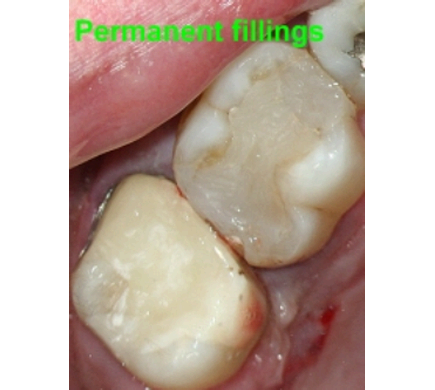 |
Crowns are necessary to prevent fracture of the cusps and provide a long-term seal |
Cracks?
Cracks can develop on any tooth, especially if one grinds or clenches and has numerous large fillings. Typically a crack starts small, develops slowly over time, and then becomes problematic.
The following patient was seen by Dr. Fransen at the Richmond Endodontic Centre and demonstrates a typical crack tooth scenario. The tooth had two old fillings that had been problem free for over 20 years. Then about one year prior to seeking treatment some minor cold sensitivity was noticed. The gentleman did not consult a dentist but endured the sensitivity for several weeks until it eventually passed. No more sensitivity or problems were noticed for several months. Then, out of the blue, some tenderness to bite developed. The bite sensitivity rapidly worsened to the point where even light touch would elicit a lot of pain. The extreme pain motivated the gentleman to consult with his dentist who then referred him to the Richmond Endodontic Centre for further evaluation.

Typically, only large cracks can be seen on an x-ray. However, this x-ray is helpful in that small spaces can be seen between the fillings and tooth structure. The tooth no longer responded to hot or cold tests. The pulp had died and root canal treatment was necessary to relieve the pain and save the tooth.
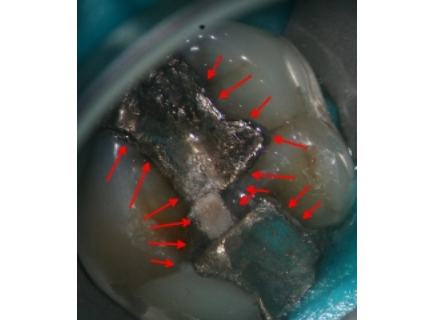
Numerous small cracks along the edges of fillings

Dr. Fransen initiated endodontic treatment and discovered a large crack extending across the floor of the pulp chamber. The tooth had split in half and could not be saved. It was extracted and a bridge or implant is necessary to replace the missing tooth.
The crack was a lot smaller when the cold sensitivity first developed. As the crack became larger the pulp died and no longer responded to cold, hot, or sweets. The gentleman mistakenly thought this was a sign that all was well. However, the crack continued to develop and eventually the tooth split in half.
If a dental evaluation was performed when the cold sensitivity first arose the natural tooth could have been saved
An on-lay or crown could have protected this tooth against splitting in half. Endodontic treatment could have resolved the sensitivity and pain. However, timely dental treatment was not sought and the tooth had to be extracted. Saving a tooth through endodontics and fillings or crowns is less expensive than the alternatives (a bridge or implant).
Toothache?
A toothache is a symptom of an inflamed or infected pulp. Endodontic treatment will relieve and prevent pain. Modern local anaesthetics and advanced techniques ensure there is no pain or sensitivity during the appointment.
Endodontic treatment removes the pulp, bacteria, and débris from the canals in teeth. This eliminates the pulp as a source of pain. However, the bone surrounding the tooth and root will require time to heal. As the healing occurs a throbbing sensation and sensitivity to bite may be present.
For a few days after the treatment, a tooth may be sensitive to bite with some slight throbbing. If a tooth was sore prior to endodontic treatment it is more likely to have some tenderness after the 'freezing' wears off. The discomfort can be relieved with over-the-counter or prescription medications. Please refer to the pain medication hand-out for a guideline on how to minimise any possible discomfort.
Whenever, root canal treatment is performed it is important to follow the pain medication instructions. If the pain is not controlled or swelling develops please contact our office immediately
(T 604.274.3499).
